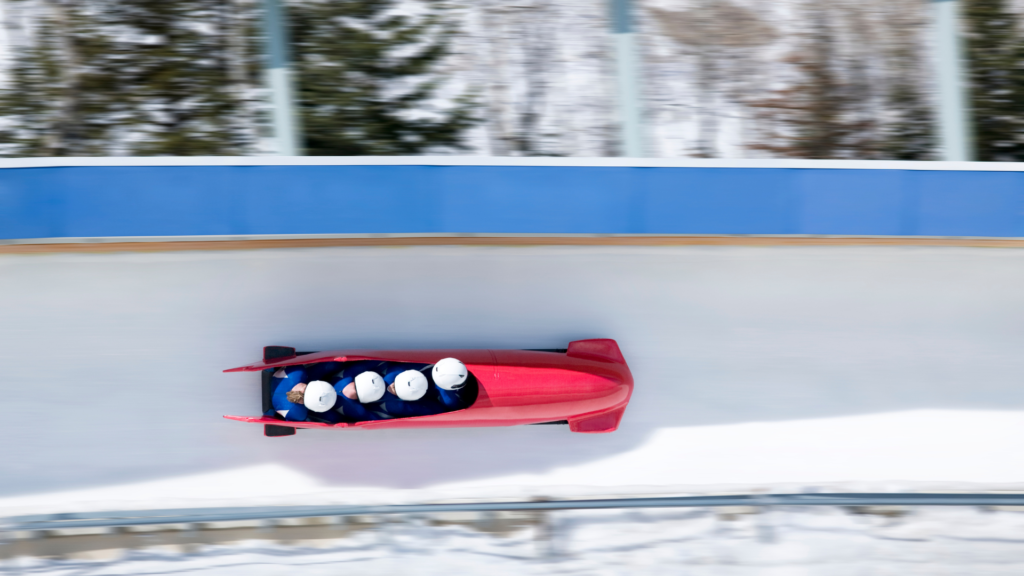There’s a lot we can learn from Olympians and what it takes to be the greatest of all time. During the 2022 Winter Olympics, I’ve been thinking a lot about how the building blocks of Olympic greatness can also be building blocks of a very Agile team or organization.
From curlers to bobsledders, each Olympian and their team builds skills in the context of a different set of rules and processes.
They reach the Olympics because of two key attributes: Discipline and continuous improvement.
It’s hard enough for one individual to have enough discipline and drive for improvement to make it to the Olympics, so how can we build these traits into whole business teams and organizations?
I’ll pretend to be an athlete, which is quite a stretch of the imagination. I do a little bit of biking, but I’m by no means a decent athlete. Professional athletes know the protocol for practicing their respective sports, but some have found better results using a different workout routine. This is continuous improvement: not relying on previous recipes.
An interesting thing about sports is it’s a really confined domain. Success in sports is usually focused on being able to execute best as a team within a confined set of rules.
The world of Agile is not as constrained or confined. We’re delivering to an ever-changing marketplace with an ever-changing regulatory environment. We’re doing lots of different things to solve unique problems. And unlike sports, we can change the way we work together and some of the rules of the game within our organizations or teams.
Think you might perform better with a 5-person bobsled team or a 10-person curling team in the Olympics? You are out of luck in the sports world. Want to make changes like that in your Agile team? Not a problem.
Agilists have a focus on doing the necessary work to get good results. For athletes in the Olympics, maybe that means formalizing a workout routine, getting up at 4 AM, or doing lots of different types of exercises and constantly changing it up.
We can’t improve without doing the work and being somewhat disciplined about understanding what’s working and what’s not. Once we understand what is working and what is not, we’re going to focus on continuous improvement, getting better.
Methods like Scrum, Kanban, and the Scaled Agile Framework (SAFe®) have continuous improvement loops built into them. To do them in a disciplined way is to change them. If you’re doing Scrum with discipline, then you treat the retrospective like it’s a real thing and that may take you off the Scrum process. In my mind, that’s OK as long as you can show me that you’re better performing as a team. Want to apply these methods to work outside of software development or IT? You certainly can.
For example, Kanban is used in service delivery, developing legal briefs, running lean startup experiments, manufacturing and personal productivity. Scrum is used in manufacturing, design, bio-medical research delivering services and educational content, and preparing to repair nuclear power plants to name a few domains.
I don’t care whether you’re Scrum compliant, Kanban compliant, SAFe compliant, or something else. No one should care about your process. If you focus too much on the process, then you’re likely getting into situations where people are applying things that don’t always work.
“Well it’s part of the process, it’s just the way we do things around here.”
No. I want you to be disciplined in what you do and how you do it. And, you should focus on continuous improvement.

Teams need to care about what they’re doing. From an organizational perspective, different teams may be doing different things. So how should you measure success? Process compliance? Delivering Value? I think the latter is the only way to measure success and improvement. If teams concentrate on discipline & continuous improvement, this is where real Agility comes in.
The outcomes of discipline and continuous improvement are three-fold:
Outcome 1. Value Flow
Value flow includes speed. Can we go from idea to measurable outcome quickly? And can we ensure that we built the right thing that’s moving the outcome in the right direction?
If teams can’t do the above, then something is broken. They’re not going to be successful. This team costs money. If we can’t realize actual value from the money we’re spending, we do not need the team. Period. it costs more to run than the value they produce either in current value or future value or execution on some mission, then we don’t need the teams so they’re not going to be successful
There’s a metrics component as well, not just an idea about value but understanding if we actually stuck the landing on that Left Double 1620 with a safety grab, like Eileen Gu since we are using the olympic metaphor. And by the way it was the first time she had tried that trick on snow. Talk about discipline and improvising a needed improvement when you are faced with a challenge.
Validated value delivery as determined by the marketplace.
So we should just go as fast as possible and build as much stuff as possible? Well, not really. The other two attributes are balancing attributes because we want to create a system where the team and the organization are playing the long game.
Outcome 2. Quality
Businesses certainly have some quarterly results they want to hit, but they want to be in business five years from now. We all want to go fast and realize value but we need to do that with appropriate quality.
If the business shuts down, or if your team makes a big mistake, then appropriate quality is high. The quality needs to be balanced by the flow and speed.
And I use the word ‘appropriate’ very specifically. It’s a balancing act. The faster we go, we might trade off quality for speed. That’s where the concept of technical debt comes in. Technical debt is meant to be an instrument to buy speed by giving up a little bit of quality, but you have to pay it off in the future.
The ideas of quality and appropriate quality are easy to map into the Olympics in many disciplines. Lay down the best quality you can to get into the medals and have the discipline to have your last run, jump, curling stone throw be just good enough to keep you in contention. The discipline to know what not too much, not too little is. Quality that is just right to get the job done.
Say I’m working on a prototype. I could spend months and months polishing it and when I finally show it to my users, they say “No, that’s not right.” I’ve wasted all that effort. What if I just did a quick wireframe and got some reactions to that before diving deep into the building? That would have been appropriate quality.
DevOps provides lots of really cool tools. Tools that that first XP team – Kent Beck, Ron Jeffries, Ward Cunningham – planted the seeds of and they’re coming to fruition today. We’ve got lots of great tools that allow us to evaluate quality quickly through automation and get things out and flow that value fast.
Outcome 3. Sustainability
And there’s another attribute that’s a little softer that I want to throw in as a balancing attribute and that is not speed, because we took care of speed with value flow getting things done quickly. It has a little bit to do with quality, and that last attribute is:
Can the people, the company come back month after month, week after week, sprint after sprint, and sustain delivery over time at the appropriate quality and continue to deliver quickly?
In the case of the Olympic metaphor, we have seen the effect of not working sustainably. Many athletes sadly over train or do not take a long term approach to their careers and may get a single shot before they burn out. We also have examples of people that focus on long term continuous improvement and are disciplined at their product (fitness and skill) and their process (physical and mental training, focus and long term view) and go on to have long careers in their sport.

Go for the Gold
Discipline, continuous improvement, value, quality and sustainability have been the focus of lean organizations for many, many years. And the process in lean organizations evolves each day, hour, week, and month.
As of this writing, Team USA has taken the silver medal in the 2022 Winter Olympics Team Figure Skating Event. They did not do so by doing exactly the same thing that the amazing athletes of the past did. The team event has only been around in the Olympics since 2018. They did it by taking the best ideas from the past, improving on those ideas and making up new ideas to expand the sport. We are now talking about the possibility that someone may land a Quintuple jump in the Olympics in my lifetime. The Quad revolution was started in 1988. How did they get so far so fast?
Discipline and continuous improvement.
Let the games begin (besides the Olympics)
Watch Bob’s related presentation “Real Agility.”
Build your team’s olympic-style agility with a custom agile team workshop – contact us.

